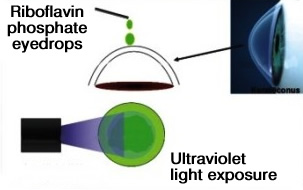Keratoconus Treatment
For the treatment of keratoconus, Corneal Collagen Cross-linking using Riboflavin involves the application of Riboflavin drops to the cornea, followed by exposure of the cornea to low dose ultraviolet A light. The activated riboflavin induces collagen fibrils (the glue that holds the body together) to thicken, stiffen, & re-attach i.e. cross-link to each other creating new bonds between the adjacent collagen molecules leading to increase in the rigidity and thereby rendering cornea less malleable.
What is collagen cross-linking?
Collagen cross-linking is a new treatment for keratoconus, which uses a photosensitizing agent, riboflavin (vitamin B2) and ultraviolet light (UVA, 365um) exposure. Ultraviolet light is used to promote increased cross-linking between collagen fibres within the cornea. The 3 & 5 year results of Dresden clinical study in human eyes has shown the arrest of progression of keratoconus in all treated eyes. (Wollensak G. Crosslinking treatment of progressive keratoconus: New Hope. Current Opinion in Ophthalmology 2006; 17:356 360)
How is treatment done?
The treatment is performed under topical anaesthesia. The skin (epithelium) of the surface of the cornea is partially scratched, followed by application of Riboflavin eye drops for 30 minutes. The eye is then exposed to UVA light for 30 minutes.
After treatment, antibiotic drops are applied, a bandage contact lens is put in place and a clear eye shield is worn overnight until the next day when the surface of the eye has healed. Oral analgesics are required for the first 1-2 days.
Is Ultraviolet light harmful?
Ultraviolet A light used in this procedure is not harmful to the eye in measured doses. The light-emitting diodes used in the C3-R device is of a wavelength that is not harmful. Furthermore, light emission is carefully measured and calibrated prior to each treatment.
How often will I need to follow up?
You will be seen soon after the procedure to remove the contact lens and you will remain on eye drops for a few weeks. You will be seen at one month, three months, six months and one year. Following this, it is important that you be seen on an annual basis.
When can I wear contact lenses again?
You may return to wearing lenses after one month. Your lenses may need to be changed if your cornea changes shape.
Advantages of Crosslinking Treatment with Riboflavin
- No injection, no stitches & no incisions as in Keratoplasty
- Quick & easy treatment with low costs.
- Simple one-time treatment
- Halts the progress and causes some regression
- Causes an increase in corneal stiffness of the anterior 200-250 μm
- Deeper structures don‘t get damaged
Corneal Allogenic Intrastromal Ring Segments (CAIRS) Treatment is another advanced treatment for Keratoconus. Read more..